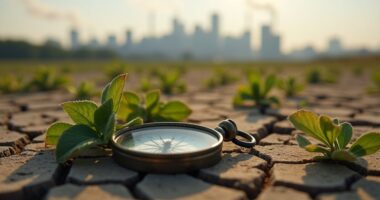America’s 2025 Sustainability Playbook looks impressive, but it grapples with hidden hurdles that could derail its ambitions. While it champions renewable energy, the push for fossil fuels looms large, resembling trading a sleek bike for a gas-guzzler. Furthermore, essential initiatives like public transportation funding cuts threaten eco-friendly goals, and flood insurance reforms leave vulnerable communities at risk. It’s like trying to build a house on a shaky foundation. What’s next in the sustainability saga? Keep an eye out!
America’s Sustainability Playbook: A Risky Gamble
Imagine the Arctic Wildlife Refuge, a serene haven for wildlife, suddenly transformed into a bustling oil rig. The Playbook’s vision of energy independence sounds appealing until you realize it’s like trading your bike for a gas-guzzling monster truck, leaving renewable energy development in the dust.
The Inflation Reduction Act, which once promised a cleaner future, now faces the chopping block, reminiscent of a bad horror flick where the hero’s plans keep getting derailed. The plan’s intention to maximize corporate oil and gas extraction could undermine the progress made in renewable energy. This shift could lead to an increase of 2.7 billion metric tons of carbon emissions by 2030, further exacerbating climate change.
Moreover, the prospect of replacing the National Flood Insurance Program with private insurers raises eyebrows. It’s akin to asking a fox to guard the henhouse: high-risk properties might find themselves without the support they desperately need as climate-induced flooding becomes the new normal.
Replacing the National Flood Insurance Program with private insurers is like inviting a fox into the henhouse—disastrous for high-risk properties.
While the Playbook claims to prioritize economic stability, proposed cuts to public transportation funding could lead to a resurgence of smog-filled highways, as more people resort to driving—an environmentally regressive twist. Developing integrated management systems could help organizations better balance environmental protection with safety considerations during this transition.
Add in the potential $7.7 billion increase in consumer energy costs, and one starts to wonder if this Playbook is more of a recipe for disaster than a sustainable strategy.
Finally, the lack of support for environmental justice initiatives risks leaving vulnerable communities gasping for breath amidst pollution. As corporate interests take precedence, the dream of equitable climate policy may become nothing more than a fading mirage.
In this high-stakes narrative, America’s 2025 Sustainability Playbook is a bold script, yet it teeters on the edge of failure as it navigates the complexities of environmental stewardship.









